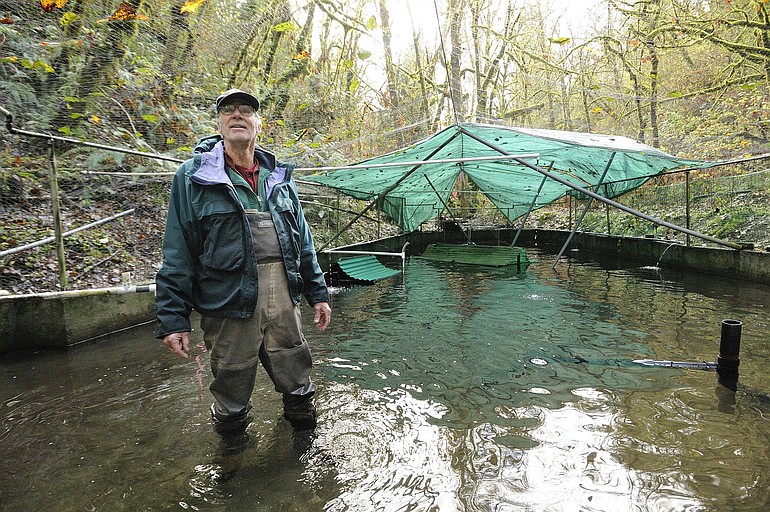When Dave Brown began scooping up tiny salmon stranded in drying creeks near his Battle Ground-area home several years ago, he had no way of gauging whether it would boost anemic fish runs in local rivers.
He only knew one thing for sure: Fish would die if he didn’t act.
Brown and his ever-growing cadre of volunteers scoop stranded wild juvenile coho and steelhead, then place them in a series of pens Brown assembled on his property off 259th Street near Mill Creek. Fed by groundwater springs, the pens keep the fish alive until Brown can release them back into native streams swollen by autumn rains.
Turned loose, the fish go along their way.
But how many survive long enough to make their way downstream, migrate to the ocean and return two or three years later to spawn the next generation?
In 2008, a group of biologists decided to find out.
Northwest Marine Technology in Tumwater agreed to provide almost $5,000 worth of coded wire tags and equipment. On Tuesday, a group of volunteers finished inserting the last of 34,000 tags injected into fatty tissue above the snout. Each tag, roughly the size of a grain of rice, contains a six-character code identifying the fish as one of Brown’s.
Now, three years later, Brown’s chickens are just beginning to come home to roost.
Anytime one of these fish is caught in the ocean or collected in a survey of spawning habitat, biologists can detect the presence of the tag by waving a wand across the head, which is then lopped off and sent to laboratories in Alaska, British Columbia, Washington, Oregon or California to gather more information from the tags.
“They’ve got a whole freezer full of heads up in Olympia,” Brown said.
Indeed, a few dozen of Brown’s brood have already been identified after being caught as full-grown adults along the West Coast in ocean fisheries. Even though lower Columbia River wild coho are protected under the Endangered Species Act, state and federal fishery managers allowed these fish to be marked and ultimately killed on the theory that the fish would have died anyway without Brown’s help.
Biologists praise the efforts of the volunteer fish rescuers, but Northwest Marine Technology wanted a scientific evaluation of the results.
They figure 34,000 tags should be just enough to compare the survival rate of wild fish rescued by Brown to those raised in nearby hatcheries, said Lee Blankenship, a retired state biologist who heads the company’s biological staff. Brown, a lifelong fisherman, believes the results will show it’s no contest.
“In the wild, in all species, the female picks her mate,” Brown said.
Brown’s fish have emerged from gravel spawning grounds, in contrast to the eggs of fish fertilized and then raised in protected concrete raceways at hatcheries. Through natural selection, he said, the fittest salmon survive to spawn the next generation.
Yet, after a century of habitat degradation and overfishing, hatcheries now account for the overwhelming majority of salmon that return to the Columbia River basin. Hatcheries provide the basis for popular sport, commercial and tribal fisheries; a recent federal proposal to curtail hatchery production to conserve wild runs has already run into stiff opposition.
Brown said his program offers a better blueprint, but Blankenship isn’t so sure.
“It won’t replace hatcheries, in my opinion,” Blankenship said. “You couldn’t get to a large enough scale.”
Even so, he extols the work by Brown and other volunteers as a great way to conserve wild fish in areas where tributaries are drying up. In Clark County, a proliferation of asphalt and rooftops has constricted the landscape’s natural ability to absorb rain and recharge groundwater.
Geraldine Vander Haegen, a biologist with Northwest Marine Technology who has tagged fish in each of the past three years, envisions other programs popping up around the Northwest to boost wild runs.
“It gives you another tool, another chance to get production from streams that are being dewatered,” she said.
Brice Crayne, an AmeriCorps worker who helped tag Brown’s fish this week, said even hatcheries stand to benefit from conserving a strong genetic pool carried forward by fish capable of spawning in the wild.
“It’s not like cattle. It’s not like chickens,” Crayne said. “When the hatcheries fail, we’re not going to have fish.”
Erik Robinson: 360-735-4551, or erik.robinson@columbian.com.



